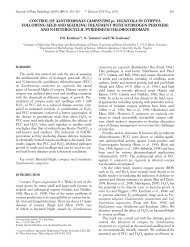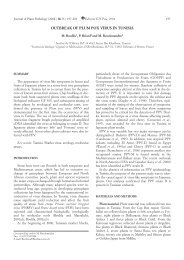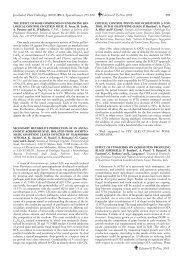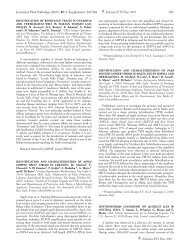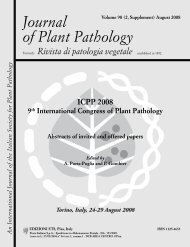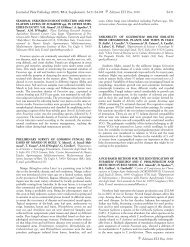Journal of Plant Pathology - Sipav.org
Journal of Plant Pathology - Sipav.org
Journal of Plant Pathology - Sipav.org
Create successful ePaper yourself
Turn your PDF publications into a flip-book with our unique Google optimized e-Paper software.
<strong>Journal</strong> <strong>of</strong> <strong>Plant</strong> <strong>Pathology</strong> (2011), 93 (1, Supplement), S1.43-S1.51 Edizioni ETS Pisa, 2011 S1.43<br />
GRAPEVINE-PLASMOPARA VITICOLA INTERACTION.<br />
H.H. Kassemeyer. Staatliches Weinbauinstitut, Merzhauser<br />
Strasse 119, 79100 Freiburg im Breisgau, Germany. E-mail: hannsheinz.kassemeyer@wbi.bwl.de<br />
The grapevine pathogen Plasmopara viticola belongs to the<br />
oomycetes, which differ from the true fungi. P. viticola originates<br />
from the south-east <strong>of</strong> the USA, where it occurs on wild<br />
grapevine species such as Vitis aestivalis and V. riparia. In 1878,<br />
symptoms <strong>of</strong> downy mildew caused by P. viticola were detected<br />
for the first time in Europe in the south-west <strong>of</strong> France. The following<br />
disastrous pandemic <strong>of</strong> downy mildew in Europe revealed<br />
the high susceptibility <strong>of</strong> the European Vitis vinifera cultivars. In<br />
the opposite, the wild American species express a more or less effective<br />
resistance. Recent findings on the interaction pathogens/<br />
host plants reveal new insights in defence response <strong>of</strong> the plants<br />
and disclose new aspects about susceptibility and resistance. The<br />
aim <strong>of</strong> this work was to characterize both resistance and susceptibility<br />
to P. viticola <strong>of</strong> grapevine genotypes. We are studying the<br />
infection process and the host plant response at the molecular,<br />
biochemical and structural level. For this purpose, we are looking<br />
for genes in the pathogen and the host plant involved in the particular<br />
interaction. In this context we have cloned and sequenced<br />
putative defence genes such as PR proteins and have followed the<br />
course <strong>of</strong> colonization <strong>of</strong> host tissue with microscope observations.<br />
To analyse the kinetics <strong>of</strong> defence response and the transcriptional<br />
activity <strong>of</strong> PR proteins after a challenge infection by P.<br />
viticola, a quantitative PCR (qPCR) by means <strong>of</strong> real time PCR<br />
was developed. The quantification <strong>of</strong> the PR protein activation<br />
revealed differences in the time course <strong>of</strong> the transcription <strong>of</strong> a β-<br />
1,3 glucanase, belonging to the PR2 family (VPR2). Transcription<br />
<strong>of</strong> VPR2 was activated within the first 12 h post inoculation (hpi)<br />
in the resistant genotypes resulting in a continued approximately<br />
20 to 30 fold induction. In susceptible genotypes only a slight increase<br />
<strong>of</strong> the VPR2 transcript occurred not until 48 hpi. By<br />
means <strong>of</strong> epifluorescence microscopy (EFM) and low temperature<br />
scanning electron microscopy (LTSEM) the specific infection<br />
stages were analyzed. In the susceptible genotype, P. viticola<br />
established itself within 12 hpi in host tissues and formed a substomatal<br />
vesicle with primary hyphae. At that time, the primary<br />
hyphae had already grown in the intercellular spaces <strong>of</strong> the host<br />
plant mesophyll. After 24 hpi, primary hyphae quickly colonized<br />
the intercellular spaces and branched. At 48 hpi, the branched<br />
hyphae eventually formed a mycelium. In the resistant genotype,<br />
however, the pathogen ceased its further development after 24<br />
hpi and no mycelium was formed. The comparison <strong>of</strong> gene induction<br />
with the course <strong>of</strong> infection and colonization <strong>of</strong> the host<br />
tissue by P. viticola showed a distinct pathogen development in<br />
resistant and susceptible genotypes. In the former, P. viticola was<br />
able to form penetration structures and a few haustoria, but<br />
mycelial growth and development <strong>of</strong> haustoria was not as abundant<br />
as in the susceptible genotypes. Molecular and microscopic<br />
studies indicated that in resistant genotypes the defense response<br />
was activated within a short time after the first contact between<br />
host and pathogen. We assume that the first contact between the<br />
penetration peg and the guard cells during the penetration<br />
process plays a crucial role in resistance induction. The inhibition<br />
<strong>of</strong> further pathogen development after the formation <strong>of</strong> the first<br />
haustoria in the resistant genotypes supports this assumption.<br />
MOLECULAR AND CYTOLOGICAL RESPONSES OF<br />
GRAPEVINE AGAINST DOWNY MILDEW CAUSED BY<br />
PLASMOPARA VITICOLA. M. Selim 1,2 , G. Langen 2 , B.<br />
Berkelmann-Löhnertz 3 , K.H. Kogel 2 and D. Evers 1 . 1 Centre de<br />
Recherche Public-Gabriel Lippmann, Department Environment<br />
and Agro-Biotechnologies, 41 Rue du Brill, 4422 Belvaux, Luxembourg.<br />
2 Research Centre for BioSystems, Land Use and Nutrition,<br />
Justus Liebig University Giessen, 26 Heinrich-Buff-Ring, 35392<br />
Giessen, Germany. 3 Geisenheim Research Center, Institute <strong>of</strong><br />
Biology, Department <strong>of</strong> Phytomedicine, 1 von-Lade-Strasse, 65366<br />
Geisenheim, Germany. E-mail: selim@lippmann.lu; evers@<br />
lippmann.lu<br />
Downy mildew, caused by Plasmopara viticola, is one <strong>of</strong> the<br />
most destructive grapevine diseases in Europe and in the eastern<br />
half <strong>of</strong> the United States. In 1996, almost 10% <strong>of</strong> the sales value<br />
<strong>of</strong> the global fungicide market was for grapevine’s downy mildew.<br />
Therefore, induced resistance to P. viticola is an appealing<br />
method for controlling the disease in a more sustainable way.<br />
This work aims at inducing the plant’s defence mechanisms<br />
against P. viticola by some (biogenic and abiogenic) elicitors,<br />
through a protective method, where the elicitor is applied before<br />
the infection, as well as through a curative method, where the<br />
elicitor is applied after the infection. Disease severity was recorded<br />
to assess the elicitor’s efficacy. The level <strong>of</strong> induced resistance<br />
was estimated through assessment <strong>of</strong> callose deposition as well as<br />
through a study <strong>of</strong> the expression <strong>of</strong> some defence-related genes.<br />
Disease severity analysis showed that the protective treatment<br />
was more efficient than the curative treatment. Callose deposition<br />
was more abundant in the protective than in the curative treatment.<br />
At the molecular level, the gene expression <strong>of</strong> some defence<br />
related genes (chitinase1b, lipoxygenase, stilbene synthase)<br />
was analysed using real-time RT-PCR. Results showed differential<br />
expression <strong>of</strong> these genes between the different treatments. For<br />
example, in the curative treatment, non infected plants (only<br />
elicited) showed a higher expression <strong>of</strong> the above-mentioned<br />
genes in comparison with the infected plants.<br />
NEW STRATEGIES FOR MILDEW RESISTANCE BREED-<br />
ING IN GRAPEVINE. R. Eibach and R. Töpfer. Federal Research<br />
Centre for Cultivated <strong>Plant</strong>s, Julius Kuehn-Institute, Institute<br />
for Grapevine Breeding, Geilweilerh<strong>of</strong>, 76833 Siebeldingen,<br />
Germany. E-mail: rudolf.eibach@jki.bund.de<br />
Since the introduction <strong>of</strong> phylloxera and mildew diseases<br />
from North America to Europe during the second part <strong>of</strong> the<br />
19 th century, grape breeders around the world have been engaged<br />
in the introduction <strong>of</strong> resistance traits existing in wild American<br />
and Asian Vitis species into the gene pool <strong>of</strong> European quality<br />
vines. These activities have led to remarkable success for cultivars<br />
with high wine quality and a high degree <strong>of</strong> resistance against<br />
downy and powdery mildews were obtained, thus allowing a considerable<br />
reduction <strong>of</strong> plant protection. Recent research on the<br />
genetics and inheritance <strong>of</strong> resistance traits have led to the identification<br />
<strong>of</strong> different loci for both downy and powdery mildew.<br />
These loci can be tagged by molecular markers so that the use <strong>of</strong><br />
marker-assisted selection (MAS) allows the identification in a<br />
crossed population <strong>of</strong> genotypes that have inherited resistance-related<br />
loci from their parents. When crossing parents with different<br />
resistance loci, MAS allows seedling selection within the <strong>of</strong>fspring<br />
that carries resistance loci from both female and male parent.<br />
It is expected that this kind <strong>of</strong> pyramiding resistance loci in<br />
new cultivars increases resistance level with respect to resistance<br />
sustainability. Currently, the breeding programme is directed to<br />
pyramiding six resistance-related loci, three <strong>of</strong> them related to<br />
downy mildew and the other three related to powdery mildew.<br />
The first breeding lines established with the combination <strong>of</strong> four<br />
loci (two each for downy and powdery mildew) exhibit a very<br />
high degree <strong>of</strong> resistance to both mildews. One <strong>of</strong> these lines was<br />
used for a further cross for adding an additional powdery<br />
Edizioni ETS Pisa, 2011



